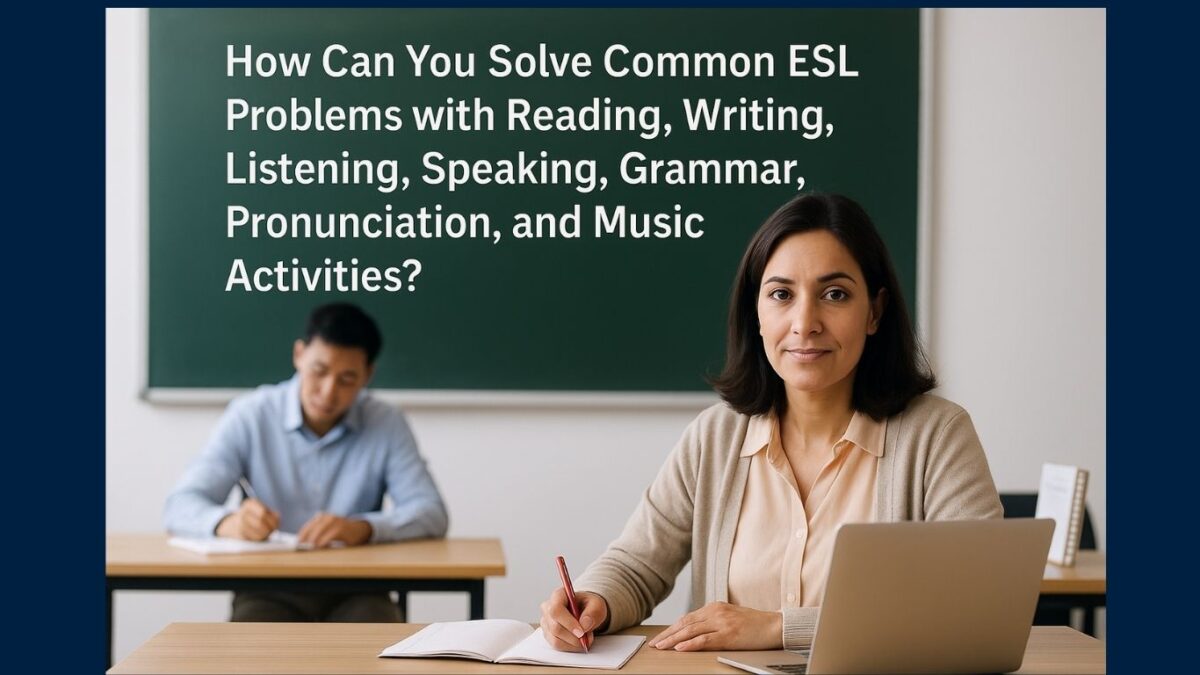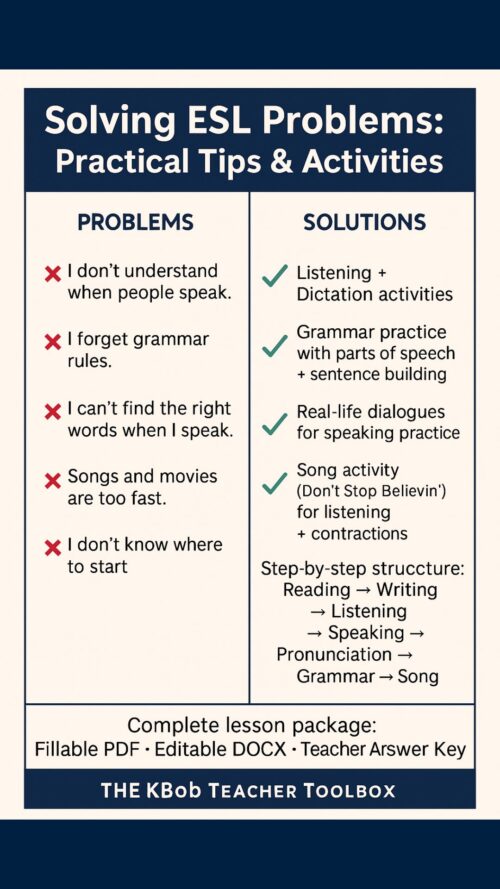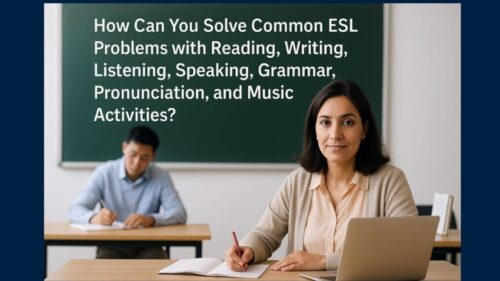Practical tips and activities to solve common ESL problems: reading, writing, listening, speaking, grammar, and pronunciation.

Guess what? When you click and buy through our links, you’re doing more than improving your game. You’re supporting us in a way that doesn’t cost you extra but helps us keep bringing you the best drills and tips. It’s a slam dunk for both of us!
ESL students often struggle with more than just grammar — they face challenges in reading, writing, listening, speaking, pronunciation, and confidence. This guide explains the most common problems and gives you clear, ready-to-use solutions. It also connects you to a complete TPT lesson and YouTube video walkthrough so you can take these ideas straight to the classroom.
Summary
- Practical solutions to common ESL struggles
- Sample activities you can use today
- Links to a full ready-to-go lesson (TPT)
- Free downloadable sample
Table of Contents
- What are the biggest problems ESL students face?
- How can reading and writing activities help?
- What listening and dictation strategies really work?
- How do dialogues improve speaking skills?
- What’s the best way to teach pronunciation?
- How do we make grammar less confusing?
- Can music really help ESL learners?
- Where can I get a complete ready-to-use lesson?
What are the biggest problems ESL students face?
Many ESL students experience difficulties that go beyond just learning vocabulary lists or grammar rules. They often struggle to understand fast spoken English, forget grammar structures when speaking, or feel nervous using English in real contexts. Reading can feel slow and discouraging, writing may lack structure, and pronunciation challenges make communication harder. Teachers also report that learners lose confidence when progress feels slow.
- Struggles: comprehension, fluency, grammar retention, fear of speaking.

How can reading and writing activities help?
Reading exposes learners to real-life grammar, everyday phrases, and lots of new words. Starting with short stories, articles, or graded readers gives students manageable text to work with.
Pairing reading with writing activities, such as writing a journal entry or summarizing what they read, helps build memory and confidence.
Sharing written work in small groups or responding to reading questions encourages active learning and gives everyone a voice. Promoting peer review adds extra motivation for students to produce clear written work, since they know classmates will read it.
- Short passages build reading fluency and confidence.
- Comprehension questions help students focus on meaning.
- Sentence starters guide students into short paragraphs
| Sentence Starter | Student Example |
|---|---|
| My favorite food is … | My favorite food is pizza because it is delicious. |
| I usually … | I usually wake up at 6:30 and drink coffee. |
Encourage use of Google Translate to support vocabulary learning. For extended reading and writing support, check out programs like Rocket Languages.
What listening and dictation strategies really work?
Listening tasks are really important, but it’s easy to get lost if the audio is too fast or complicated. Short, focused dictation exercises are super useful. Just play a sentence one or two times and have students write what they hear.
This builds listening accuracy and supports spelling, too. Mixing in podcasts, songs, or short news clips gives learners lots of variety and prepares them for different accents and speaking speeds. Whenever possible, include follow-up comprehension checks or discussion to reinforce what students have heard.
- Use the three-pass listening method: listen → chunked listen → listen again.
- Dictation: 5 sentences, progressively harder, based on lesson vocabulary.
- “Hello, my name is _____. I usually wake up at _____ in the morning.”
To build listening skills outside class, English Class 101 offers short audio lessons with transcripts that pair perfectly with dictation practice.
How do dialogues improve speaking skills?
Dialogues give ESL students a structured way to practice real conversations.
Role-plays and scripted dialogues let students try out new language in a safe setting. Repeating short, practical phrases is especially helpful for shy learners or those with limited vocabulary.
When students switch roles or create their own endings, it keeps things interesting, making practice feel more authentic.
Having students record themselves and listen back can increase self-awareness and improve confidence over time. Practicing common social dialogues, such as greetings or ordering food, gives skills that translate directly to real-world situations.
- Characters Rosa & Ahmed create continuity across lessons.
- Role-play builds fluency and confidence.
- Personalize dialogues: change bus number, workplace, or daily routine.
Rosa: Hi, I’m Rosa. Are you waiting for the ____?
Ahmed: Yes, the number ____ bus. I’m Ahmed. Nice to meet you.
For even more real conversation practice, encourage students to connect with a tutor on italki.
What’s the best way to teach pronunciation?
Pronunciation causes a lot of frustration but doesn’t have to be a chore.
Focus on tricky individual sounds, like “th” or “r,” stress, and intonation patterns. Tongue twisters and repetition exercises are pretty handy, plus they add a bit of humor to class.
Speech recognition apps or simple recordings help students hear their progress and give a boost to self-awareness. Including games, mimicking activities, and peer playback sessions keeps the mood light and participation high.
- Focus on word stress and sentence stress.
- Use Google Translate audio for practice
| Word | Stress |
| market | MAR-ket |
| computer | com-PU-ter |
| tomato | to-MA-to |
| beginner | be-GIN-ner |
For structured pronunciation practice with feedback, Mondly offers interactive speaking and listening activities.
How do we make grammar less confusing?
Grammar gets a bad rap, but interactive activities help a lot.
Turning grammar points into games or quick writing challenges makes things less intimidating. Visual aids, such as charts and color coding, can be really helpful for showing patterns.
Connecting grammar to real-life tasks, including writing an email or placing an order at a restaurant, puts rules into clear context and keeps practice practical. Encourage students to ask questions and explain grammar concepts to each other to reinforce their own understanding.
- Teach 8 parts of speech with examples.
- Practice with sentence completeness: ✓ or ✗.
- Use a word bank for sentence building.
- Word Bank → Build sentences using: I, they, dog, Maria, run, study, eat, big, quickly, school, English.
Structured online practice with Rocket Languages can reinforce classroom grammar instruction.
Can music really help ESL learners?
Music gets attention and sticks in learners’ minds longer than a worksheet ever could.
Songs introduce new vocabulary, natural pronunciation, and grammar in a memorable way. Activities like gap-fill lyrics, singing along, or discussing a song’s message build listening, speaking, and critical thinking all at once.
Even shy students usually enjoy music-based practice. Incorporate movement, rhythm, or dance to make memorable language connections; this works especially well with young learners, but can liven up adult classes, too. Use popular tunes or catchy original songs to keep students motivated between lessons.
- Music helps with rhythm, contractions, and memory.
- Don’t Stop Believin’ teaches contractions like livin’, goin’, believin’.
“Just a small town ____
Livin’ in a lonely ____”
Where can I get a complete ready-to-use lesson?
- Full TPT lesson: Solving ESL Problems: Complete No-Prep Lesson for Adults.
- Includes: Fillable PDF, Editable DOCX, Teacher Answer Key, Teacher Notes.
- Perfect for in-person or online adult ESL/ELL classes.
Visit the TPT Store to grab this complete lesson.
Final Thoughts
What do you think?
What’s the biggest challenge your students face? Comment below!
Grab the complete lesson in my TPT store, join the Study Buddy Project, or explore the full resource library.
Has this lesson been helpful for you? Did I leave anything out? Do you have any questions?
I’d love to hear from you.
Tell me what you think.
I always reply.
Get My Free English GuideAdultESL #ESLLesson #EnglishPractice #LearnEnglish #ESLReading #ESLWriting #ESLListening #ESLSpeaking #ESLPronunciation #ESLGrammar #ESLProblems #EnglishTips #NoPrepESL #ELLResources #EnglishTeacher


This is such a well-rounded and practical guide for tackling the challenges ESL learners face! I really appreciate how it goes beyond grammar drills and offers creative ways like using music, dialogues, and real-life tasks to make learning more engaging and less intimidating. The tips about reading and writing paired together, as well as using apps and peer feedback, feel especially helpful for building confidence. I’m curious what’s one activity you’ve seen ESL students enjoy the most, even the shy ones, and how did it help them open up?
Hi Kavitha, thanks for your comments. Of course, no single activity is enjoyable to everyone but, one thing that seems to be most popular for most students is games, especially competitive games where one team faces the other. They seem to really get into that. Quizlet and Kahoot are two that I use. Burlington English also has games built into its curriculum.
KBob